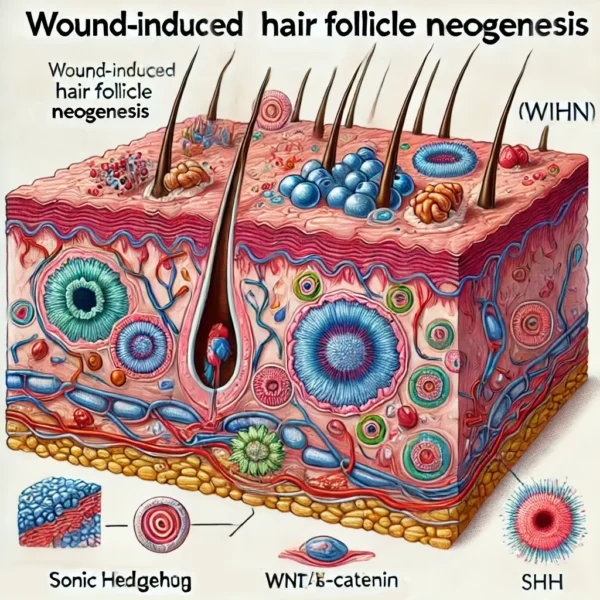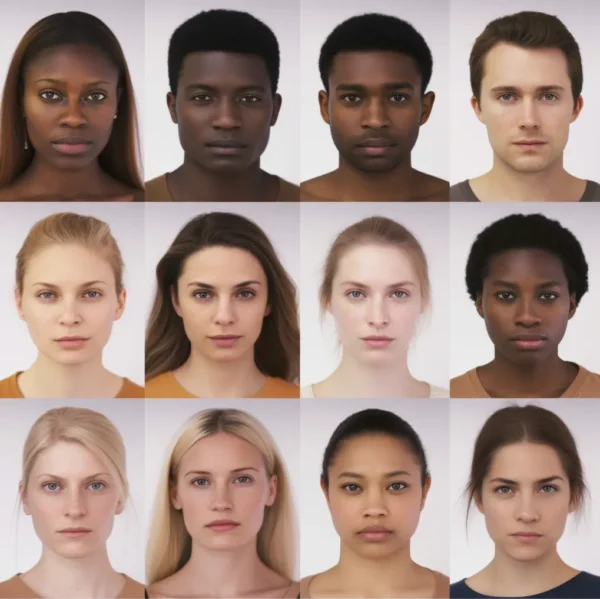Ear hair, a subject that has intrigued scientists and medical professionals for decades, offers a fascinating intersection of genetics, evolution, and health. This article delves into the intricacies of ear hair, drawing from a variety of sources to present a comprehensive understanding of this often overlooked aspect of human biology.
The Nature of Ear Hair: In the early stages of life and embryo development, the ear, particularly the tragus, is often covered with lanugo-like hairs, which eventually get replaced by secondary hairs. Most commonly, lanugo hairs are shed when still inside the womb and the hair is replaced by tiny vellus hairs. However, occasionally the ears of new-borns are still covered with these conspicuous lanugo-like hairs. On the pinna, they converge toward a point at about the site of Darwin’s tubercle (it’s a slight swelling on the outer rim of the ear, you can see it if you take a look in the mirror), giving the infant a particularly “fawnlike” appearance when viewed from the side. This lanugo hair is not a concern, eventually it will be replaced with typical vellus hair.
For most women and many men, the ear hairs retain a downy vellus character throughout their lives. However, as observed by Danforth in 1925, in some men, especially from the third decade onwards, long lanugo-like hairs, and/or coarse pigmented terminal hairs, begin to appear on the ear tragus and the pinna. Most clinicians believe this change is most likely due to hormonal influences, particularly the increase in dihydrotestosterone (DHT), which stimulates hair growth in various body areas. Having said that, a few clinicians disagree and believe that hairy ears are not due to androgen activity, but rather the condition is a result of a genetic hypertrichosis. So far, there is no direct research data to prove androgens promote ear hair growth.
The length that ear hair can achieve is quite remarkable. The record for the longest ear hair belongs to an individual from India, whose ear hair impressively measures 7 inches, originating from the center and top of his ears.
The Evolution of Ear Hair: The evolutionary role of ear hair is not entirely clear, but it is thought to be part of the body’s general hair growth patterns. The primary function of ear hair, like other body hair, is believed to be protective. Ear hair probably helps in blocking dust, debris, and small particles from entering the ear canal. It might also help prevent UV light penetrance into the inner ear areas.
A letter published in “Med Hypotheses” suggests that hairy ears might actually enhance the hearing power of an individual. The authors theorized that the hairs present on the outer area of the ear might have sensory activity that could augment hearing ability, particularly in older individuals where the occurrence and degree of hairiness increases. There is no evidence to support this view, but the idea is intriguing.
Demographic Perspectives: Surprisingly, there have been many studies into how common hairy ears are in various parts of the world. Much of the research was published in anthropology journals in the 1950s-1970s. In these studies, hairy ears are usually defined as having one or more terminal pigmented hairs on the pinna or external acoustic meatus of the ear. The anthropologists then look at a large number of people in a particular geographic region or in a specific ethnic group and count the number with hairy ears.
Unsurprisingly, the occurrence of ear hair varies significantly among populations in different countries. All the studies note that hairy ears are predominantly found in elderly males, with a significantly lower occurrence in females. A few women do develop hairy ears – though in all studies less than 0.5% of the female population are affected. For men the number with hairy ears increases with age in all the populations that have been looked at across the world. The average rate of hairy ears in men can be as low as around 5% and as high as 33% in different populations. It’s most common in men who live in India and Sri Lanka. Unusually, data for the USA is lacking.
Genetic Perspectives: Like other hair characteristics, the presence and amount of ear hair are influenced by genetics. Some individuals may have a genetic predisposition to grow more ear hair than others. This is probably why hairy ears are most commonly found in some parts of India and Sri Lanka.
For around 100 years, the scientific community has debated the genetic inheritance pattern of the Hairy Ears trait, also known as “Hypertrichosis Pinnae Auris” and “Auricular hypertrichosis”. This trait is characterized by hair growth on the external part of the ear. Initially, several pedigree studies published in the 1900s-1930s suggested Y-chromosome linked inheritance, as the trait seemed to pass from fathers to sons. This view of hairy ear inheritance persisted into the 1970s. However, further scrutiny and re-examination of various traits previously thought to be Y-linked have led to doubts about this conclusion.
The evidence was further complicated by observations in certain populations, where the trait appeared to be Y-linked, but issues such as reduced trait expression, age-dependent onset, and cosmetic hair removal made conclusions difficult. Moreover, the presence of the trait in some female subjects (albeit not very many) challenged the idea of strict Y-linkage. Questions as to whether hairy ears were really linked to the Y chromosome began to be raised in the 1980s onwards. Recent comprehensive analyses of the Y chromosome have not identified any genes likely to cause this hair growth pattern, suggesting that the trait may not be Y-linked at all. This view aligns with the broader scientific understanding that very few traits are actually linked to the Y chromosome.
At the moment there is no solid conclusion to the debate. While some maintain that hairy ears may be due to a Y-linked pattern of inheritance, others believe an autosomal gene is responsible. A third hypothesis suggests an interaction of two loci, one on the homologous part of the X and Y chromosome and another on the non-homologous Y chromosome region.
Health Implications of Hairy Ears: The presence of ear hair, particularly in the ear canal, has health implications. For instance, one case study in involving a man with bilateral sensorineural hearing loss highlighted the complications of dense hairs in the external auditory canals. In another example, a man could not use an in-ear hearing aid because ear hair prevented keeping the hearing-aid in place. These cases underscore the importance of managing ear hair, especially in the context of auditory health. For those with very hairy ears, and particularly if the hair is growing into the inner hair canal, the ear hair has is removed by clinicians as there is a risk of damage to hearing, both from the hair itself and from the procedure to remove the hair.
Several other case reports published over the years have described men with other complications of hairy ears including one example of an individual complaining of a persistent scratching type sound in one ear. After ear hair removal, which was found compacted against the tympanic membrane, this problem immediately disappeared. Compacted ear hair can also cause complications such as local inflammation in the ear. If ear inflammation persists it can promote vertigo as the inner ears contain organs of Corti – the loop-shaped canals containing fluid and fine, hair-like sensors that help you keep your balance.
Surprisingly, there have been at least two case reports of patients with persistent hiccups being cured after their ear hair removal. The authors of these case reports speculate that a hiccup reflex within the third cervical portion of the phrenic nerve could be initiated by hairs irritating the inner ear canal and/or the tympanic membrane.
Furthermore, the association between ear-canal hair and an increased risk for coronary artery disease (CAD) has been pointed out in various studies. For example, Ali et al. in 2010 noted that 37.2% of CAD patients had hairy ear canals, a higher prevalence than other known CAD risk factors like hypertension or diabetes.
Caution in Ear Hair Removal: The use of hair removal or depilatory creams, for ear hair is probably quite risky, according to at least one journal article. These creams can cause local allergic reactions and disrupt the integrity of the skin, potentially altering the pharmacodynamics of topical ear drops. Plus if there is an inflammatory response it might affect hearing and perhaps even balance control if it is severe enough.
In some barber shops, a popular service offered is the removal of ear hair by carefully burning it. However, there are risks with this ear hair removal technique. Smoke from burning hair contains chemical carcinogen fumes. These chemicals can irritate the airways and, in theory at least, they could cause cancer with long-term repeated exposure.
For those who choose to remove ear hair, methods include trimming, plucking, and laser hair removal. Battery powered ear hair trimmers are widely available and quite effective. It is very important to be gentle and avoid deep insertion of any instruments into the ear canal to prevent injury and damage to the tympanic membrane.
Conclusions: The study of ear hair, from its evolutionary roots to its genetic underpinnings and health implications, reveals a microcosm of human biology’s complexity. It underscores the intricate interplay between our genetic makeup and environmental factors, and how these can manifest in seemingly trivial but medically significant traits. As research continues to unravel the mysteries of ear hair, it provides valuable insights into broader themes of human health and disease.
Bibliography
11711645 {11711645:QWAEN86H},{11711645:ADD8IHJP},{11711645:89D7VKT2},{11711645:7397A9GP},{11711645:66F6Z2JR},{11711645:RI8H9GXW},{11711645:I2GNC5SH},{11711645:CQ9GIBA2},{11711645:ZIAJCG9P},{11711645:DR7QUDHK},{11711645:JW5XRFXR},{11711645:VATPMUT8},{11711645:TCRNAZW2},{11711645:TKDK6J7A},{11711645:RNVKNIDW},{11711645:WVT6A9ST},{11711645:SCKJ6TWQ},{11711645:CE6PBFQT},{11711645:JP6C3R9I},{11711645:MWAP4IMA} 1 vancouver 50 date asc 685 https://www.keratin.com/wp-content/plugins/zotpress/ %7B%22status%22%3A%22success%22%2C%22updateneeded%22%3Afalse%2C%22instance%22%3Afalse%2C%22meta%22%3A%7B%22request_last%22%3A0%2C%22request_next%22%3A0%2C%22used_cache%22%3Atrue%7D%2C%22data%22%3A%5B%7B%22key%22%3A%22I2GNC5SH%22%2C%22library%22%3A%7B%22id%22%3A11711645%7D%2C%22meta%22%3A%7B%22creatorSummary%22%3A%22Danforth%22%2C%22parsedDate%22%3A%221925%22%2C%22numChildren%22%3A0%7D%2C%22bib%22%3A%22%26lt%3Bdiv%20class%3D%26quot%3Bcsl-bib-body%26quot%3B%20style%3D%26quot%3Bline-height%3A%201.35%3B%20%26quot%3B%26gt%3B%5Cn%20%20%26lt%3Bdiv%20class%3D%26quot%3Bcsl-entry%26quot%3B%20style%3D%26quot%3Bclear%3A%20left%3B%20%26quot%3B%26gt%3B%5Cn%20%20%20%20%26lt%3Bdiv%20class%3D%26quot%3Bcsl-left-margin%26quot%3B%20style%3D%26quot%3Bfloat%3A%20left%3B%20padding-right%3A%200.5em%3B%20text-align%3A%20right%3B%20width%3A%201em%3B%26quot%3B%26gt%3B1.%26lt%3B%5C%2Fdiv%26gt%3B%26lt%3Bdiv%20class%3D%26quot%3Bcsl-right-inline%26quot%3B%20style%3D%26quot%3Bmargin%3A%200%20.4em%200%201.5em%3B%26quot%3B%26gt%3BDanforth%20CH.%20Hair%26%23x202F%3B%3A%20with%20special%20reference%20to%20hypertrichosis.%20Chicago%3A%20American%20Medical%20Association%3B%201925.%20152%20p.%26lt%3B%5C%2Fdiv%26gt%3B%5Cn%20%20%20%26lt%3B%5C%2Fdiv%26gt%3B%5Cn%26lt%3B%5C%2Fdiv%26gt%3B%22%2C%22data%22%3A%7B%22itemType%22%3A%22book%22%2C%22title%22%3A%22Hair%20%3A%20with%20special%20reference%20to%20hypertrichosis%22%2C%22creators%22%3A%5B%7B%22creatorType%22%3A%22author%22%2C%22firstName%22%3A%22C.H.%22%2C%22lastName%22%3A%22Danforth%22%7D%5D%2C%22abstractNote%22%3A%22%22%2C%22date%22%3A%221925%22%2C%22language%22%3A%22en%22%2C%22ISBN%22%3A%22%22%2C%22url%22%3A%22%22%2C%22collections%22%3A%5B%22X5TESU9S%22%5D%2C%22dateModified%22%3A%222023-08-23T14%3A50%3A54Z%22%7D%7D%2C%7B%22key%22%3A%22ZIAJCG9P%22%2C%22library%22%3A%7B%22id%22%3A11711645%7D%2C%22meta%22%3A%7B%22creatorSummary%22%3A%22Dronamraju%22%2C%22parsedDate%22%3A%221961-05%22%2C%22numChildren%22%3A0%7D%2C%22bib%22%3A%22%26lt%3Bdiv%20class%3D%26quot%3Bcsl-bib-body%26quot%3B%20style%3D%26quot%3Bline-height%3A%201.35%3B%20%26quot%3B%26gt%3B%5Cn%20%20%26lt%3Bdiv%20class%3D%26quot%3Bcsl-entry%26quot%3B%20style%3D%26quot%3Bclear%3A%20left%3B%20%26quot%3B%26gt%3B%5Cn%20%20%20%20%26lt%3Bdiv%20class%3D%26quot%3Bcsl-left-margin%26quot%3B%20style%3D%26quot%3Bfloat%3A%20left%3B%20padding-right%3A%200.5em%3B%20text-align%3A%20right%3B%20width%3A%201em%3B%26quot%3B%26gt%3B1.%26lt%3B%5C%2Fdiv%26gt%3B%26lt%3Bdiv%20class%3D%26quot%3Bcsl-right-inline%26quot%3B%20style%3D%26quot%3Bmargin%3A%200%20.4em%200%201.5em%3B%26quot%3B%26gt%3BDronamraju%20KR.%20Frequencies%20of%20Hairy%20Pinn%26%23xE6%3B%20among%20Indian%20and%20Sinhalese%20Peoples.%20Nature.%201961%20May%3B190%284776%29%3A653%26%23x2013%3B653.%26lt%3B%5C%2Fdiv%26gt%3B%5Cn%20%20%20%26lt%3B%5C%2Fdiv%26gt%3B%5Cn%26lt%3B%5C%2Fdiv%26gt%3B%22%2C%22data%22%3A%7B%22itemType%22%3A%22journalArticle%22%2C%22title%22%3A%22Frequencies%20of%20Hairy%20Pinn%5Cu00e6%20among%20Indian%20and%20Sinhalese%20Peoples%22%2C%22creators%22%3A%5B%7B%22creatorType%22%3A%22author%22%2C%22firstName%22%3A%22K.%20R.%22%2C%22lastName%22%3A%22Dronamraju%22%7D%5D%2C%22abstractNote%22%3A%22SINCE%20Tommasi1%2C2%20published%20a%20small%20pedigree%2C%20one%20of%20the%20phenotypes%20suspected%20to%20be%20holandrically%20inherited%20in%20human%20beings%20is%20that%20called%20hypertrichosis%20of%20the%20ears%20but%20more%20accurately%20hypertrichosis%20of%20the%20pinnae%20of%20the%20ears.%20I%20have%20shown%20this%20to%20be%20completely%20Y-linked%20in%20my%20family%2C%20publishing%20a%20pedigree%20containing%20181%20people%20of%207%20generations3.%20The%20age%20of%20onset%20is%20usually%20in%20late%20puberty%2C%20though%20in%20a%20few%20cases%20the%20hairs%20are%20not%20conspicuous%20until%20the%20men%20are%20about%2025.%22%2C%22date%22%3A%221961-05%22%2C%22language%22%3A%22en%22%2C%22DOI%22%3A%2210.1038%5C%2F190653a0%22%2C%22ISSN%22%3A%221476-4687%22%2C%22url%22%3A%22%22%2C%22collections%22%3A%5B%22RJISCQKN%22%5D%2C%22dateModified%22%3A%222023-12-16T16%3A32%3A21Z%22%7D%7D%2C%7B%22key%22%3A%2266F6Z2JR%22%2C%22library%22%3A%7B%22id%22%3A11711645%7D%2C%22meta%22%3A%7B%22creatorSummary%22%3A%22Cardi%22%2C%22parsedDate%22%3A%221961-08-10%22%2C%22numChildren%22%3A0%7D%2C%22bib%22%3A%22%26lt%3Bdiv%20class%3D%26quot%3Bcsl-bib-body%26quot%3B%20style%3D%26quot%3Bline-height%3A%201.35%3B%20%26quot%3B%26gt%3B%5Cn%20%20%26lt%3Bdiv%20class%3D%26quot%3Bcsl-entry%26quot%3B%20style%3D%26quot%3Bclear%3A%20left%3B%20%26quot%3B%26gt%3B%5Cn%20%20%20%20%26lt%3Bdiv%20class%3D%26quot%3Bcsl-left-margin%26quot%3B%20style%3D%26quot%3Bfloat%3A%20left%3B%20padding-right%3A%200.5em%3B%20text-align%3A%20right%3B%20width%3A%201em%3B%26quot%3B%26gt%3B1.%26lt%3B%5C%2Fdiv%26gt%3B%26lt%3Bdiv%20class%3D%26quot%3Bcsl-right-inline%26quot%3B%20style%3D%26quot%3Bmargin%3A%200%20.4em%200%201.5em%3B%26quot%3B%26gt%3BCardi%20E.%20Hiccups%20Associated%20with%20Hair%20in%20the%20External%20Auditory%20Canal%20%26%23x2014%3B%20Successful%20Treatment%20by%20Manipulation.%20N%20Engl%20J%20Med.%201961%20Aug%2010%3B265%286%29%3A286%26%23x2013%3B286.%26lt%3B%5C%2Fdiv%26gt%3B%5Cn%20%20%20%26lt%3B%5C%2Fdiv%26gt%3B%5Cn%26lt%3B%5C%2Fdiv%26gt%3B%22%2C%22data%22%3A%7B%22itemType%22%3A%22journalArticle%22%2C%22title%22%3A%22Hiccups%20Associated%20with%20Hair%20in%20the%20External%20Auditory%20Canal%20%5Cu2014%20Successful%20Treatment%20by%20Manipulation%22%2C%22creators%22%3A%5B%7B%22creatorType%22%3A%22author%22%2C%22firstName%22%3A%22Erminio%22%2C%22lastName%22%3A%22Cardi%22%7D%5D%2C%22abstractNote%22%3A%22%22%2C%22date%22%3A%221961-08-10%22%2C%22language%22%3A%22en%22%2C%22DOI%22%3A%2210.1056%5C%2FNEJM196108102650608%22%2C%22ISSN%22%3A%220028-4793%2C%201533-4406%22%2C%22url%22%3A%22%22%2C%22collections%22%3A%5B%22RJISCQKN%22%5D%2C%22dateModified%22%3A%222023-12-17T15%3A27%3A03Z%22%7D%7D%2C%7B%22key%22%3A%22CE6PBFQT%22%2C%22library%22%3A%7B%22id%22%3A11711645%7D%2C%22meta%22%3A%7B%22creatorSummary%22%3A%22Trapp%22%2C%22parsedDate%22%3A%221963-03%22%2C%22numChildren%22%3A0%7D%2C%22bib%22%3A%22%26lt%3Bdiv%20class%3D%26quot%3Bcsl-bib-body%26quot%3B%20style%3D%26quot%3Bline-height%3A%201.35%3B%20%26quot%3B%26gt%3B%5Cn%20%20%26lt%3Bdiv%20class%3D%26quot%3Bcsl-entry%26quot%3B%20style%3D%26quot%3Bclear%3A%20left%3B%20%26quot%3B%26gt%3B%5Cn%20%20%20%20%26lt%3Bdiv%20class%3D%26quot%3Bcsl-left-margin%26quot%3B%20style%3D%26quot%3Bfloat%3A%20left%3B%20padding-right%3A%200.5em%3B%20text-align%3A%20right%3B%20width%3A%201em%3B%26quot%3B%26gt%3B1.%26lt%3B%5C%2Fdiv%26gt%3B%26lt%3Bdiv%20class%3D%26quot%3Bcsl-right-inline%26quot%3B%20style%3D%26quot%3Bmargin%3A%200%20.4em%200%201.5em%3B%26quot%3B%26gt%3BTrapp%20JD.%20An%20unusual%20cause%20of%20intractable%20hiccups%3A%20a%20hair%20in%20the%20external%20auditory%20canal.%20South%20Med%20J.%201963%20Mar%3B56%3A325%26%23x2013%3B6.%26lt%3B%5C%2Fdiv%26gt%3B%5Cn%20%20%20%26lt%3B%5C%2Fdiv%26gt%3B%5Cn%26lt%3B%5C%2Fdiv%26gt%3B%22%2C%22data%22%3A%7B%22itemType%22%3A%22journalArticle%22%2C%22title%22%3A%22An%20unusual%20cause%20of%20intractable%20hiccups%3A%20a%20hair%20in%20the%20external%20auditory%20canal%22%2C%22creators%22%3A%5B%7B%22creatorType%22%3A%22author%22%2C%22firstName%22%3A%22J.%20D.%22%2C%22lastName%22%3A%22Trapp%22%7D%5D%2C%22abstractNote%22%3A%22%22%2C%22date%22%3A%221963-03%22%2C%22language%22%3A%22eng%22%2C%22DOI%22%3A%2210.1097%5C%2F00007611-196303000-00021%22%2C%22ISSN%22%3A%221541-8243%22%2C%22url%22%3A%22%22%2C%22collections%22%3A%5B%22RJISCQKN%22%5D%2C%22dateModified%22%3A%222023-12-16T15%3A56%3A59Z%22%7D%7D%2C%7B%22key%22%3A%22SCKJ6TWQ%22%2C%22library%22%3A%7B%22id%22%3A11711645%7D%2C%22meta%22%3A%7B%22creatorSummary%22%3A%22Stern%20et%20al.%22%2C%22parsedDate%22%3A%221964-12%22%2C%22numChildren%22%3A0%7D%2C%22bib%22%3A%22%26lt%3Bdiv%20class%3D%26quot%3Bcsl-bib-body%26quot%3B%20style%3D%26quot%3Bline-height%3A%201.35%3B%20%26quot%3B%26gt%3B%5Cn%20%20%26lt%3Bdiv%20class%3D%26quot%3Bcsl-entry%26quot%3B%20style%3D%26quot%3Bclear%3A%20left%3B%20%26quot%3B%26gt%3B%5Cn%20%20%20%20%26lt%3Bdiv%20class%3D%26quot%3Bcsl-left-margin%26quot%3B%20style%3D%26quot%3Bfloat%3A%20left%3B%20padding-right%3A%200.5em%3B%20text-align%3A%20right%3B%20width%3A%201em%3B%26quot%3B%26gt%3B1.%26lt%3B%5C%2Fdiv%26gt%3B%26lt%3Bdiv%20class%3D%26quot%3Bcsl-right-inline%26quot%3B%20style%3D%26quot%3Bmargin%3A%200%20.4em%200%201.5em%3B%26quot%3B%26gt%3BStern%20C%2C%20Centerwall%20WR%2C%20Sarkar%20SS.%20New%20data%20on%20the%20problem%20of%20Y-linkage%20of%20hairy%20pinnae.%20Am%20J%20Hum%20Genet.%201964%20Dec%3B16%284%29%3A455%26%23x2013%3B71.%26lt%3B%5C%2Fdiv%26gt%3B%5Cn%20%20%20%26lt%3B%5C%2Fdiv%26gt%3B%5Cn%26lt%3B%5C%2Fdiv%26gt%3B%22%2C%22data%22%3A%7B%22itemType%22%3A%22journalArticle%22%2C%22title%22%3A%22New%20data%20on%20the%20problem%20of%20Y-linkage%20of%20hairy%20pinnae%22%2C%22creators%22%3A%5B%7B%22creatorType%22%3A%22author%22%2C%22firstName%22%3A%22C.%22%2C%22lastName%22%3A%22Stern%22%7D%2C%7B%22creatorType%22%3A%22author%22%2C%22firstName%22%3A%22W.%20R.%22%2C%22lastName%22%3A%22Centerwall%22%7D%2C%7B%22creatorType%22%3A%22author%22%2C%22firstName%22%3A%22S.%20S.%22%2C%22lastName%22%3A%22Sarkar%22%7D%5D%2C%22abstractNote%22%3A%22%22%2C%22date%22%3A%221964-12%22%2C%22language%22%3A%22eng%22%2C%22DOI%22%3A%22%22%2C%22ISSN%22%3A%220002-9297%22%2C%22url%22%3A%22%22%2C%22collections%22%3A%5B%22RJISCQKN%22%5D%2C%22dateModified%22%3A%222023-12-16T16%3A40%3A00Z%22%7D%7D%2C%7B%22key%22%3A%22DR7QUDHK%22%2C%22library%22%3A%7B%22id%22%3A11711645%7D%2C%22meta%22%3A%7B%22creatorSummary%22%3A%22el%20Wakil%20et%20al.%22%2C%22parsedDate%22%3A%221967-12%22%2C%22numChildren%22%3A0%7D%2C%22bib%22%3A%22%26lt%3Bdiv%20class%3D%26quot%3Bcsl-bib-body%26quot%3B%20style%3D%26quot%3Bline-height%3A%201.35%3B%20%26quot%3B%26gt%3B%5Cn%20%20%26lt%3Bdiv%20class%3D%26quot%3Bcsl-entry%26quot%3B%20style%3D%26quot%3Bclear%3A%20left%3B%20%26quot%3B%26gt%3B%5Cn%20%20%20%20%26lt%3Bdiv%20class%3D%26quot%3Bcsl-left-margin%26quot%3B%20style%3D%26quot%3Bfloat%3A%20left%3B%20padding-right%3A%200.5em%3B%20text-align%3A%20right%3B%20width%3A%201em%3B%26quot%3B%26gt%3B1.%26lt%3B%5C%2Fdiv%26gt%3B%26lt%3Bdiv%20class%3D%26quot%3Bcsl-right-inline%26quot%3B%20style%3D%26quot%3Bmargin%3A%200%20.4em%200%201.5em%3B%26quot%3B%26gt%3Bel%20Wakil%20HE%2C%20el%20Gewely%20MR%2C%20Dronamraju%20KR.%20The%20age%20of%20onset%20of%20hypertrichosis%20pinnae%20auris%20among%20Egyptians.%20Hum%20Biol.%201967%20Dec%3B39%284%29%3A414%26%23x2013%3B7.%26lt%3B%5C%2Fdiv%26gt%3B%5Cn%20%20%20%26lt%3B%5C%2Fdiv%26gt%3B%5Cn%26lt%3B%5C%2Fdiv%26gt%3B%22%2C%22data%22%3A%7B%22itemType%22%3A%22journalArticle%22%2C%22title%22%3A%22The%20age%20of%20onset%20of%20hypertrichosis%20pinnae%20auris%20among%20Egyptians%22%2C%22creators%22%3A%5B%7B%22creatorType%22%3A%22author%22%2C%22firstName%22%3A%22H.%20E.%22%2C%22lastName%22%3A%22el%20Wakil%22%7D%2C%7B%22creatorType%22%3A%22author%22%2C%22firstName%22%3A%22M.%20R.%22%2C%22lastName%22%3A%22el%20Gewely%22%7D%2C%7B%22creatorType%22%3A%22author%22%2C%22firstName%22%3A%22K.%20R.%22%2C%22lastName%22%3A%22Dronamraju%22%7D%5D%2C%22abstractNote%22%3A%22%22%2C%22date%22%3A%221967-12%22%2C%22language%22%3A%22eng%22%2C%22DOI%22%3A%22%22%2C%22ISSN%22%3A%220018-7143%22%2C%22url%22%3A%22%22%2C%22collections%22%3A%5B%22RJISCQKN%22%5D%2C%22dateModified%22%3A%222023-12-16T16%3A25%3A54Z%22%7D%7D%2C%7B%22key%22%3A%22QWAEN86H%22%2C%22library%22%3A%7B%22id%22%3A11711645%7D%2C%22meta%22%3A%7B%22creatorSummary%22%3A%22Ali%22%2C%22parsedDate%22%3A%221972-03%22%2C%22numChildren%22%3A0%7D%2C%22bib%22%3A%22%26lt%3Bdiv%20class%3D%26quot%3Bcsl-bib-body%26quot%3B%20style%3D%26quot%3Bline-height%3A%201.35%3B%20%26quot%3B%26gt%3B%5Cn%20%20%26lt%3Bdiv%20class%3D%26quot%3Bcsl-entry%26quot%3B%20style%3D%26quot%3Bclear%3A%20left%3B%20%26quot%3B%26gt%3B%5Cn%20%20%20%20%26lt%3Bdiv%20class%3D%26quot%3Bcsl-left-margin%26quot%3B%20style%3D%26quot%3Bfloat%3A%20left%3B%20padding-right%3A%200.5em%3B%20text-align%3A%20right%3B%20width%3A%201em%3B%26quot%3B%26gt%3B1.%26lt%3B%5C%2Fdiv%26gt%3B%26lt%3Bdiv%20class%3D%26quot%3Bcsl-right-inline%26quot%3B%20style%3D%26quot%3Bmargin%3A%200%20.4em%200%201.5em%3B%26quot%3B%26gt%3BAli%20SG.%20Hairy%20pinnae%20in%20Kerala.%20Am%20J%20Phys%20Anthropol.%201972%20Mar%3B36%282%29%3A153%26%23x2013%3B5.%26lt%3B%5C%2Fdiv%26gt%3B%5Cn%20%20%20%26lt%3B%5C%2Fdiv%26gt%3B%5Cn%26lt%3B%5C%2Fdiv%26gt%3B%22%2C%22data%22%3A%7B%22itemType%22%3A%22journalArticle%22%2C%22title%22%3A%22Hairy%20pinnae%20in%20Kerala%22%2C%22creators%22%3A%5B%7B%22creatorType%22%3A%22author%22%2C%22firstName%22%3A%22S.%20G.%22%2C%22lastName%22%3A%22Ali%22%7D%5D%2C%22abstractNote%22%3A%22%22%2C%22date%22%3A%221972-03%22%2C%22language%22%3A%22eng%22%2C%22DOI%22%3A%2210.1002%5C%2Fajpa.1330360202%22%2C%22ISSN%22%3A%220002-9483%22%2C%22url%22%3A%22%22%2C%22collections%22%3A%5B%22RJISCQKN%22%5D%2C%22dateModified%22%3A%222023-12-16T16%3A38%3A49Z%22%7D%7D%2C%7B%22key%22%3A%22RI8H9GXW%22%2C%22library%22%3A%7B%22id%22%3A11711645%7D%2C%22meta%22%3A%7B%22creatorSummary%22%3A%22Cotton%20et%20al.%22%2C%22parsedDate%22%3A%221972-05%22%2C%22numChildren%22%3A0%7D%2C%22bib%22%3A%22%26lt%3Bdiv%20class%3D%26quot%3Bcsl-bib-body%26quot%3B%20style%3D%26quot%3Bline-height%3A%201.35%3B%20%26quot%3B%26gt%3B%5Cn%20%20%26lt%3Bdiv%20class%3D%26quot%3Bcsl-entry%26quot%3B%20style%3D%26quot%3Bclear%3A%20left%3B%20%26quot%3B%26gt%3B%5Cn%20%20%20%20%26lt%3Bdiv%20class%3D%26quot%3Bcsl-left-margin%26quot%3B%20style%3D%26quot%3Bfloat%3A%20left%3B%20padding-right%3A%200.5em%3B%20text-align%3A%20right%3B%20width%3A%201em%3B%26quot%3B%26gt%3B1.%26lt%3B%5C%2Fdiv%26gt%3B%26lt%3Bdiv%20class%3D%26quot%3Bcsl-right-inline%26quot%3B%20style%3D%26quot%3Bmargin%3A%200%20.4em%200%201.5em%3B%26quot%3B%26gt%3BCotton%20SG%2C%20Nixon%20JM%2C%20Carpenter%20RG%2C%20Evans%20DW.%20Factors%20discriminating%20men%20with%20coronary%20heart%20disease%20from%20healthy%20controls.%20Br%20Heart%20J.%201972%20May%3B34%285%29%3A458%26%23x2013%3B64.%26lt%3B%5C%2Fdiv%26gt%3B%5Cn%20%20%20%26lt%3B%5C%2Fdiv%26gt%3B%5Cn%26lt%3B%5C%2Fdiv%26gt%3B%22%2C%22data%22%3A%7B%22itemType%22%3A%22journalArticle%22%2C%22title%22%3A%22Factors%20discriminating%20men%20with%20coronary%20heart%20disease%20from%20healthy%20controls%22%2C%22creators%22%3A%5B%7B%22creatorType%22%3A%22author%22%2C%22firstName%22%3A%22S.%20G.%22%2C%22lastName%22%3A%22Cotton%22%7D%2C%7B%22creatorType%22%3A%22author%22%2C%22firstName%22%3A%22J.%20M.%22%2C%22lastName%22%3A%22Nixon%22%7D%2C%7B%22creatorType%22%3A%22author%22%2C%22firstName%22%3A%22R.%20G.%22%2C%22lastName%22%3A%22Carpenter%22%7D%2C%7B%22creatorType%22%3A%22author%22%2C%22firstName%22%3A%22D.%20W.%22%2C%22lastName%22%3A%22Evans%22%7D%5D%2C%22abstractNote%22%3A%22%22%2C%22date%22%3A%221972-05%22%2C%22language%22%3A%22eng%22%2C%22DOI%22%3A%2210.1136%5C%2Fhrt.34.5.458%22%2C%22ISSN%22%3A%220007-0769%22%2C%22url%22%3A%22%22%2C%22collections%22%3A%5B%22RJISCQKN%22%5D%2C%22dateModified%22%3A%222023-12-17T15%3A31%3A46Z%22%7D%7D%2C%7B%22key%22%3A%227397A9GP%22%2C%22library%22%3A%7B%22id%22%3A11711645%7D%2C%22meta%22%3A%7B%22creatorSummary%22%3A%22Bharadwaj%20et%20al.%22%2C%22parsedDate%22%3A%221977-08%22%2C%22numChildren%22%3A0%7D%2C%22bib%22%3A%22%26lt%3Bdiv%20class%3D%26quot%3Bcsl-bib-body%26quot%3B%20style%3D%26quot%3Bline-height%3A%201.35%3B%20%26quot%3B%26gt%3B%5Cn%20%20%26lt%3Bdiv%20class%3D%26quot%3Bcsl-entry%26quot%3B%20style%3D%26quot%3Bclear%3A%20left%3B%20%26quot%3B%26gt%3B%5Cn%20%20%20%20%26lt%3Bdiv%20class%3D%26quot%3Bcsl-left-margin%26quot%3B%20style%3D%26quot%3Bfloat%3A%20left%3B%20padding-right%3A%200.5em%3B%20text-align%3A%20right%3B%20width%3A%201em%3B%26quot%3B%26gt%3B1.%26lt%3B%5C%2Fdiv%26gt%3B%26lt%3Bdiv%20class%3D%26quot%3Bcsl-right-inline%26quot%3B%20style%3D%26quot%3Bmargin%3A%200%20.4em%200%201.5em%3B%26quot%3B%26gt%3BBharadwaj%20VK%2C%20Anand%20CS%2C%20Chaurasia%20BD.%20Hair%20patterns%20of%20the%20pinna%20among%20the%20Central%20Indians.%20Anthropol%20Anz.%201977%20Aug%3B36%281%29%3A20%26%23x2013%3B6.%26lt%3B%5C%2Fdiv%26gt%3B%5Cn%20%20%20%26lt%3B%5C%2Fdiv%26gt%3B%5Cn%26lt%3B%5C%2Fdiv%26gt%3B%22%2C%22data%22%3A%7B%22itemType%22%3A%22journalArticle%22%2C%22title%22%3A%22Hair%20patterns%20of%20the%20pinna%20among%20the%20Central%20Indians%22%2C%22creators%22%3A%5B%7B%22creatorType%22%3A%22author%22%2C%22firstName%22%3A%22V.%20K.%22%2C%22lastName%22%3A%22Bharadwaj%22%7D%2C%7B%22creatorType%22%3A%22author%22%2C%22firstName%22%3A%22C.%20S.%22%2C%22lastName%22%3A%22Anand%22%7D%2C%7B%22creatorType%22%3A%22author%22%2C%22firstName%22%3A%22B.%20D.%22%2C%22lastName%22%3A%22Chaurasia%22%7D%5D%2C%22abstractNote%22%3A%22The%20hair%20patterns%20of%20the%20pinna%20have%20been%20studied%20in%20a%20selected%20sample%20of%20767%20males%20and%205%20females%20from%20Central%20India%2C%20all%20with%20hairy%20pinnae.%20The%20age%20of%20the%20males%20ranged%20from%2021%20to%2085%20years%2C%20and%20that%20of%20the%20females%20from%202.5%20months%20to%2032%20years.%20All%20subjects%20were%20healthy%20and%20did%20not%20demonstrate%20any%20endocrine%20disturbance.%20The%20commonest%20hair%20pattern%20of%20the%20elevated%20areas%20of%20the%20pinna%20among%20the%20males%20was%20the%20helico-lobulo-antitragal%2C%20whereas%20in%20the%20females%20it%20was%20the%20helical.%20The%20hair%20pattern%20of%20the%20depressed%20areas%20of%20the%20pinna%20showing%20highest%20frequency%20was%20the%20conchal.%20The%20majority%20of%20the%20hairy%20pinnae%20are%20associated%20with%20bilateral%20tragal%20hair%20and%20the%20maximo-pilose%20distribution%20of%20the%20facial%20hair.%20The%20Central%20Indian%20males%20resemble%20the%20White%20males%20in%20their%20hair%20distribution%20of%20the%20pinna.%22%2C%22date%22%3A%221977-08%22%2C%22language%22%3A%22eng%22%2C%22DOI%22%3A%22%22%2C%22ISSN%22%3A%220003-5548%22%2C%22url%22%3A%22%22%2C%22collections%22%3A%5B%22RJISCQKN%22%5D%2C%22dateModified%22%3A%222023-12-16T16%3A58%3A08Z%22%7D%7D%2C%7B%22key%22%3A%22JW5XRFXR%22%2C%22library%22%3A%7B%22id%22%3A11711645%7D%2C%22meta%22%3A%7B%22creatorSummary%22%3A%22Goldman%20and%20Toher%22%2C%22parsedDate%22%3A%221982-06-24%22%2C%22numChildren%22%3A0%7D%2C%22bib%22%3A%22%26lt%3Bdiv%20class%3D%26quot%3Bcsl-bib-body%26quot%3B%20style%3D%26quot%3Bline-height%3A%201.35%3B%20%26quot%3B%26gt%3B%5Cn%20%20%26lt%3Bdiv%20class%3D%26quot%3Bcsl-entry%26quot%3B%20style%3D%26quot%3Bclear%3A%20left%3B%20%26quot%3B%26gt%3B%5Cn%20%20%20%20%26lt%3Bdiv%20class%3D%26quot%3Bcsl-left-margin%26quot%3B%20style%3D%26quot%3Bfloat%3A%20left%3B%20padding-right%3A%200.5em%3B%20text-align%3A%20right%3B%20width%3A%201em%3B%26quot%3B%26gt%3B1.%26lt%3B%5C%2Fdiv%26gt%3B%26lt%3Bdiv%20class%3D%26quot%3Bcsl-right-inline%26quot%3B%20style%3D%26quot%3Bmargin%3A%200%20.4em%200%201.5em%3B%26quot%3B%26gt%3BGoldman%20G%2C%20Toher%20L.%20A%20hair%20in%20the%20ear%20canal%20as%20a%20cause%20of%20noise.%20N%20Engl%20J%20Med.%201982%20June%2024%3B306%2825%29%3A1553.%26lt%3B%5C%2Fdiv%26gt%3B%5Cn%20%20%20%26lt%3B%5C%2Fdiv%26gt%3B%5Cn%26lt%3B%5C%2Fdiv%26gt%3B%22%2C%22data%22%3A%7B%22itemType%22%3A%22journalArticle%22%2C%22title%22%3A%22A%20hair%20in%20the%20ear%20canal%20as%20a%20cause%20of%20noise%22%2C%22creators%22%3A%5B%7B%22creatorType%22%3A%22author%22%2C%22firstName%22%3A%22G.%22%2C%22lastName%22%3A%22Goldman%22%7D%2C%7B%22creatorType%22%3A%22author%22%2C%22firstName%22%3A%22L.%22%2C%22lastName%22%3A%22Toher%22%7D%5D%2C%22abstractNote%22%3A%22%22%2C%22date%22%3A%221982-06-24%22%2C%22language%22%3A%22eng%22%2C%22DOI%22%3A%2210.1056%5C%2Fnejm198206243062518%22%2C%22ISSN%22%3A%220028-4793%22%2C%22url%22%3A%22%22%2C%22collections%22%3A%5B%22RJISCQKN%22%5D%2C%22dateModified%22%3A%222023-12-16T16%3A07%3A19Z%22%7D%7D%2C%7B%22key%22%3A%22MWAP4IMA%22%2C%22library%22%3A%7B%22id%22%3A11711645%7D%2C%22meta%22%3A%7B%22creatorSummary%22%3A%22Wagner%20et%20al.%22%2C%22parsedDate%22%3A%221984-11-15%22%2C%22numChildren%22%3A0%7D%2C%22bib%22%3A%22%26lt%3Bdiv%20class%3D%26quot%3Bcsl-bib-body%26quot%3B%20style%3D%26quot%3Bline-height%3A%201.35%3B%20%26quot%3B%26gt%3B%5Cn%20%20%26lt%3Bdiv%20class%3D%26quot%3Bcsl-entry%26quot%3B%20style%3D%26quot%3Bclear%3A%20left%3B%20%26quot%3B%26gt%3B%5Cn%20%20%20%20%26lt%3Bdiv%20class%3D%26quot%3Bcsl-left-margin%26quot%3B%20style%3D%26quot%3Bfloat%3A%20left%3B%20padding-right%3A%200.5em%3B%20text-align%3A%20right%3B%20width%3A%201em%3B%26quot%3B%26gt%3B1.%26lt%3B%5C%2Fdiv%26gt%3B%26lt%3Bdiv%20class%3D%26quot%3Bcsl-right-inline%26quot%3B%20style%3D%26quot%3Bmargin%3A%200%20.4em%200%201.5em%3B%26quot%3B%26gt%3BWagner%20RF%2C%20Reinfeld%20HB%2C%20Wagner%20KD%2C%20Gambino%20AT%2C%20Falco%20TA%2C%20Sokol%20JA%2C%20et%20al.%20Ear-canal%20hair%20and%20the%20ear-lobe%20crease%20as%20predictors%20for%20coronary-artery%20disease.%20N%20Engl%20J%20Med.%201984%20Nov%2015%3B311%2820%29%3A1317%26%23x2013%3B8.%26lt%3B%5C%2Fdiv%26gt%3B%5Cn%20%20%20%26lt%3B%5C%2Fdiv%26gt%3B%5Cn%26lt%3B%5C%2Fdiv%26gt%3B%22%2C%22data%22%3A%7B%22itemType%22%3A%22journalArticle%22%2C%22title%22%3A%22Ear-canal%20hair%20and%20the%20ear-lobe%20crease%20as%20predictors%20for%20coronary-artery%20disease%22%2C%22creators%22%3A%5B%7B%22creatorType%22%3A%22author%22%2C%22firstName%22%3A%22R.%20F.%22%2C%22lastName%22%3A%22Wagner%22%7D%2C%7B%22creatorType%22%3A%22author%22%2C%22firstName%22%3A%22H.%20B.%22%2C%22lastName%22%3A%22Reinfeld%22%7D%2C%7B%22creatorType%22%3A%22author%22%2C%22firstName%22%3A%22K.%20D.%22%2C%22lastName%22%3A%22Wagner%22%7D%2C%7B%22creatorType%22%3A%22author%22%2C%22firstName%22%3A%22A.%20T.%22%2C%22lastName%22%3A%22Gambino%22%7D%2C%7B%22creatorType%22%3A%22author%22%2C%22firstName%22%3A%22T.%20A.%22%2C%22lastName%22%3A%22Falco%22%7D%2C%7B%22creatorType%22%3A%22author%22%2C%22firstName%22%3A%22J.%20A.%22%2C%22lastName%22%3A%22Sokol%22%7D%2C%7B%22creatorType%22%3A%22author%22%2C%22firstName%22%3A%22S.%22%2C%22lastName%22%3A%22Katz%22%7D%2C%7B%22creatorType%22%3A%22author%22%2C%22firstName%22%3A%22S.%20M.%22%2C%22lastName%22%3A%22Zeldis%22%7D%5D%2C%22abstractNote%22%3A%22%22%2C%22date%22%3A%221984-11-15%22%2C%22language%22%3A%22eng%22%2C%22DOI%22%3A%2210.1056%5C%2FNEJM198411153112012%22%2C%22ISSN%22%3A%220028-4793%22%2C%22url%22%3A%22%22%2C%22collections%22%3A%5B%22RJISCQKN%22%5D%2C%22dateModified%22%3A%222023-12-16T16%3A09%3A35Z%22%7D%7D%2C%7B%22key%22%3A%22JP6C3R9I%22%2C%22library%22%3A%7B%22id%22%3A11711645%7D%2C%22meta%22%3A%7B%22creatorSummary%22%3A%22Verma%20et%20al.%22%2C%22parsedDate%22%3A%221989%22%2C%22numChildren%22%3A0%7D%2C%22bib%22%3A%22%26lt%3Bdiv%20class%3D%26quot%3Bcsl-bib-body%26quot%3B%20style%3D%26quot%3Bline-height%3A%201.35%3B%20%26quot%3B%26gt%3B%5Cn%20%20%26lt%3Bdiv%20class%3D%26quot%3Bcsl-entry%26quot%3B%20style%3D%26quot%3Bclear%3A%20left%3B%20%26quot%3B%26gt%3B%5Cn%20%20%20%20%26lt%3Bdiv%20class%3D%26quot%3Bcsl-left-margin%26quot%3B%20style%3D%26quot%3Bfloat%3A%20left%3B%20padding-right%3A%200.5em%3B%20text-align%3A%20right%3B%20width%3A%201em%3B%26quot%3B%26gt%3B1.%26lt%3B%5C%2Fdiv%26gt%3B%26lt%3Bdiv%20class%3D%26quot%3Bcsl-right-inline%26quot%3B%20style%3D%26quot%3Bmargin%3A%200%20.4em%200%201.5em%3B%26quot%3B%26gt%3BVerma%20SK%2C%20Khamesra%20R%2C%20Mehta%20LK%2C%20Bordia%20A.%20Ear-lobe%20crease%20and%20ear-canal%20hair%20as%20predictors%20of%20coronary%20artery%20disease%20in%20Indian%20population.%20Indian%20Heart%20J.%201989%3B41%282%29%3A86%26%23x2013%3B91.%26lt%3B%5C%2Fdiv%26gt%3B%5Cn%20%20%20%26lt%3B%5C%2Fdiv%26gt%3B%5Cn%26lt%3B%5C%2Fdiv%26gt%3B%22%2C%22data%22%3A%7B%22itemType%22%3A%22journalArticle%22%2C%22title%22%3A%22Ear-lobe%20crease%20and%20ear-canal%20hair%20as%20predictors%20of%20coronary%20artery%20disease%20in%20Indian%20population%22%2C%22creators%22%3A%5B%7B%22creatorType%22%3A%22author%22%2C%22firstName%22%3A%22S.%20K.%22%2C%22lastName%22%3A%22Verma%22%7D%2C%7B%22creatorType%22%3A%22author%22%2C%22firstName%22%3A%22R.%22%2C%22lastName%22%3A%22Khamesra%22%7D%2C%7B%22creatorType%22%3A%22author%22%2C%22firstName%22%3A%22L.%20K.%22%2C%22lastName%22%3A%22Mehta%22%7D%2C%7B%22creatorType%22%3A%22author%22%2C%22firstName%22%3A%22A.%22%2C%22lastName%22%3A%22Bordia%22%7D%5D%2C%22abstractNote%22%3A%22215%20patients%20of%20different%20communities%20were%20selected%20randomly%20to%20predict%20the%20correlation%20between%20the%20ear-lobe%20crease%2C%20ear-canal%20hair%20and%20coronary%20artery%20disease.%20On%20analysis%2C%20it%20was%20found%20that%20prevalence%20of%20the%20ear-lobe%20crease%20increases%20with%20advancing%20age%2C%20and%20the%20incidence%20was%20much%20more%20higher%20in%20Sindhis%20in%20whom%20the%20overall%20incidence%20of%20CAD%20is%20also%20significantly%20high.%20Bilateral%20diagonal%20ear-lobe%20crease%20was%20found%20to%20be%20significantly%20%28P%20less%20than%200.001%29%20associated%20in%20patients%20with%20documented%20CAD%2C%20and%20a%20significant%20difference%20was%20also%20observed%20between%20men%20with%20and%20without%20CAD%20in%20the%20presence%20of%20ear-canal%20hair%20with%20age%20matched%20group.%20The%20combined%20presence%20of%20ear-lobe%20crease%20and%20ear-canal%20hair%20was%20more%20definite%20and%20more%20sensitive%20index%20of%20underlying%20CAD.%22%2C%22date%22%3A%221989%22%2C%22language%22%3A%22eng%22%2C%22DOI%22%3A%22%22%2C%22ISSN%22%3A%220019-4832%22%2C%22url%22%3A%22%22%2C%22collections%22%3A%5B%22RJISCQKN%22%5D%2C%22dateModified%22%3A%222023-12-16T16%3A07%3A47Z%22%7D%7D%2C%7B%22key%22%3A%22WVT6A9ST%22%2C%22library%22%3A%7B%22id%22%3A11711645%7D%2C%22meta%22%3A%7B%22creatorSummary%22%3A%22Papay%20et%20al.%22%2C%22parsedDate%22%3A%221989-05%22%2C%22numChildren%22%3A0%7D%2C%22bib%22%3A%22%26lt%3Bdiv%20class%3D%26quot%3Bcsl-bib-body%26quot%3B%20style%3D%26quot%3Bline-height%3A%201.35%3B%20%26quot%3B%26gt%3B%5Cn%20%20%26lt%3Bdiv%20class%3D%26quot%3Bcsl-entry%26quot%3B%20style%3D%26quot%3Bclear%3A%20left%3B%20%26quot%3B%26gt%3B%5Cn%20%20%20%20%26lt%3Bdiv%20class%3D%26quot%3Bcsl-left-margin%26quot%3B%20style%3D%26quot%3Bfloat%3A%20left%3B%20padding-right%3A%200.5em%3B%20text-align%3A%20right%3B%20width%3A%201em%3B%26quot%3B%26gt%3B1.%26lt%3B%5C%2Fdiv%26gt%3B%26lt%3Bdiv%20class%3D%26quot%3Bcsl-right-inline%26quot%3B%20style%3D%26quot%3Bmargin%3A%200%20.4em%200%201.5em%3B%26quot%3B%26gt%3BPapay%20FA%2C%20Levine%20HL%2C%20Schiavone%20WA.%20Facial%20fuzz%20and%20funny%20findings.%20Facial%20hair%20causing%20otalgia%20and%20oropharyngeal%20pain.%20Cleve%20Clin%20J%20Med.%201989%20May%3B56%283%29%3A273%26%23x2013%3B6.%26lt%3B%5C%2Fdiv%26gt%3B%5Cn%20%20%20%26lt%3B%5C%2Fdiv%26gt%3B%5Cn%26lt%3B%5C%2Fdiv%26gt%3B%22%2C%22data%22%3A%7B%22itemType%22%3A%22journalArticle%22%2C%22title%22%3A%22Facial%20fuzz%20and%20funny%20findings.%20Facial%20hair%20causing%20otalgia%20and%20oropharyngeal%20pain%22%2C%22creators%22%3A%5B%7B%22creatorType%22%3A%22author%22%2C%22firstName%22%3A%22F.%20A.%22%2C%22lastName%22%3A%22Papay%22%7D%2C%7B%22creatorType%22%3A%22author%22%2C%22firstName%22%3A%22H.%20L.%22%2C%22lastName%22%3A%22Levine%22%7D%2C%7B%22creatorType%22%3A%22author%22%2C%22firstName%22%3A%22W.%20A.%22%2C%22lastName%22%3A%22Schiavone%22%7D%5D%2C%22abstractNote%22%3A%22Three%20patients%20with%20referred%20otalgia%20and%5C%2For%20oropharyngeal%20pain%20due%20to%20ectopic%20facial%20hair%20found%20in%20either%20the%20external%20auditory%20canal%20or%20oropharynx%20were%20treated%20at%20the%20Cleveland%20Clinic%20Foundation%2C%20Department%20of%20Otolaryngology%20and%20Communicative%20Disorders.%20In%20each%20of%20these%20patients%2C%20annoying%20symptoms%20were%20relieved%20by%20simple%20removal%20of%20the%20misplaced%20facial%20hair.%20Sensory%20nerve%20innervation%20of%20the%20external%20ear%20and%20oropharynx%20and%20their%20interrelationship%20in%20referred%20pain%20are%20described%20in%20detail%20following%20the%20case%20reports.%22%2C%22date%22%3A%221989-05%22%2C%22language%22%3A%22eng%22%2C%22DOI%22%3A%2210.3949%5C%2Fccjm.56.3.273%22%2C%22ISSN%22%3A%220891-1150%22%2C%22url%22%3A%22%22%2C%22collections%22%3A%5B%22RJISCQKN%22%5D%2C%22dateModified%22%3A%222023-12-16T15%3A52%3A04Z%22%7D%7D%2C%7B%22key%22%3A%22VATPMUT8%22%2C%22library%22%3A%7B%22id%22%3A11711645%7D%2C%22meta%22%3A%7B%22creatorSummary%22%3A%22Kamalam%20and%20Thambiah%22%2C%22parsedDate%22%3A%221990-05%22%2C%22numChildren%22%3A0%7D%2C%22bib%22%3A%22%26lt%3Bdiv%20class%3D%26quot%3Bcsl-bib-body%26quot%3B%20style%3D%26quot%3Bline-height%3A%201.35%3B%20%26quot%3B%26gt%3B%5Cn%20%20%26lt%3Bdiv%20class%3D%26quot%3Bcsl-entry%26quot%3B%20style%3D%26quot%3Bclear%3A%20left%3B%20%26quot%3B%26gt%3B%5Cn%20%20%20%20%26lt%3Bdiv%20class%3D%26quot%3Bcsl-left-margin%26quot%3B%20style%3D%26quot%3Bfloat%3A%20left%3B%20padding-right%3A%200.5em%3B%20text-align%3A%20right%3B%20width%3A%201em%3B%26quot%3B%26gt%3B1.%26lt%3B%5C%2Fdiv%26gt%3B%26lt%3Bdiv%20class%3D%26quot%3Bcsl-right-inline%26quot%3B%20style%3D%26quot%3Bmargin%3A%200%20.4em%200%201.5em%3B%26quot%3B%26gt%3BKamalam%20A%2C%20Thambiah%20AS.%20Genetics%20of%20hairy%20ears%20in%20south%20Indians.%20Clin%20Exp%20Dermatol.%201990%20May%3B15%283%29%3A192%26%23x2013%3B4.%26lt%3B%5C%2Fdiv%26gt%3B%5Cn%20%20%20%26lt%3B%5C%2Fdiv%26gt%3B%5Cn%26lt%3B%5C%2Fdiv%26gt%3B%22%2C%22data%22%3A%7B%22itemType%22%3A%22journalArticle%22%2C%22title%22%3A%22Genetics%20of%20hairy%20ears%20in%20south%20Indians%22%2C%22creators%22%3A%5B%7B%22creatorType%22%3A%22author%22%2C%22firstName%22%3A%22A.%22%2C%22lastName%22%3A%22Kamalam%22%7D%2C%7B%22creatorType%22%3A%22author%22%2C%22firstName%22%3A%22A.%20S.%22%2C%22lastName%22%3A%22Thambiah%22%7D%5D%2C%22abstractNote%22%3A%22Of%20500%20individuals%20screened%20at%20the%20Out-Patient%20Clinic%2C%20Mycology%20Section%20of%20the%20Department%20of%20Dermatology%2C%20Government%20General%20Hospital%2C%20Madras%2C%2083%20adult%20males%20%2816.6%25%29%20and%20two%20adult%20females%20%280.4%25%29%20had%20hairy%20ears.%20Family%20study%20in%20five%20probands%20%28three%20males%20and%20two%20females%29%20suggests%20an%20autosomal-dominant%20sex-limited%20inheritance%20of%20this%20entity%2C%20probably%20linked%20to%20the%20genes%20for%20beard%20hairs%2C%20which%20is%20peculiar%20to%20males%20in%20South%20India%20and%20Sri%20Lanka.%20There%20has%20been%20an%20increased%20incidence%20of%20diabetes%20mellitus%20in%20the%20affected%20group.%20A%20control%20study%20made%20in%20a%20similar%20population%20of%201030%20%28680%20male%20and%20350%20female%29%20individuals%20attending%20the%20general%20medical%20and%20surgical%20out-patient%20clinics%20revealed%20hairy%20ears%20in%2023.1%25%20%28237%20male%20adults%20and%20one%20female%20adult%29.%22%2C%22date%22%3A%221990-05%22%2C%22language%22%3A%22eng%22%2C%22DOI%22%3A%2210.1111%5C%2Fj.1365-2230.1990.tb02070.x%22%2C%22ISSN%22%3A%220307-6938%22%2C%22url%22%3A%22%22%2C%22collections%22%3A%5B%22RJISCQKN%22%5D%2C%22dateModified%22%3A%222023-12-16T16%3A51%3A04Z%22%7D%7D%2C%7B%22key%22%3A%22CQ9GIBA2%22%2C%22library%22%3A%7B%22id%22%3A11711645%7D%2C%22meta%22%3A%7B%22creatorSummary%22%3A%22Dharap%20and%20Than%22%2C%22parsedDate%22%3A%221995%22%2C%22numChildren%22%3A0%7D%2C%22bib%22%3A%22%26lt%3Bdiv%20class%3D%26quot%3Bcsl-bib-body%26quot%3B%20style%3D%26quot%3Bline-height%3A%201.35%3B%20%26quot%3B%26gt%3B%5Cn%20%20%26lt%3Bdiv%20class%3D%26quot%3Bcsl-entry%26quot%3B%20style%3D%26quot%3Bclear%3A%20left%3B%20%26quot%3B%26gt%3B%5Cn%20%20%20%20%26lt%3Bdiv%20class%3D%26quot%3Bcsl-left-margin%26quot%3B%20style%3D%26quot%3Bfloat%3A%20left%3B%20padding-right%3A%200.5em%3B%20text-align%3A%20right%3B%20width%3A%201em%3B%26quot%3B%26gt%3B1.%26lt%3B%5C%2Fdiv%26gt%3B%26lt%3Bdiv%20class%3D%26quot%3Bcsl-right-inline%26quot%3B%20style%3D%26quot%3Bmargin%3A%200%20.4em%200%201.5em%3B%26quot%3B%26gt%3BDharap%20AS%2C%20Than%20M.%20Five%20anthroposcopic%20traits%20of%20the%20ear%20in%20a%20Malaysian%20population.%20Anthropologischer%20Anzeiger.%201995%3B53%284%29%3A359%26%23x2013%3B63.%26lt%3B%5C%2Fdiv%26gt%3B%5Cn%20%20%20%26lt%3B%5C%2Fdiv%26gt%3B%5Cn%26lt%3B%5C%2Fdiv%26gt%3B%22%2C%22data%22%3A%7B%22itemType%22%3A%22journalArticle%22%2C%22title%22%3A%22Five%20anthroposcopic%20traits%20of%20the%20ear%20in%20a%20Malaysian%20population%22%2C%22creators%22%3A%5B%7B%22creatorType%22%3A%22author%22%2C%22firstName%22%3A%22A.S.%22%2C%22lastName%22%3A%22Dharap%22%7D%2C%7B%22creatorType%22%3A%22author%22%2C%22firstName%22%3A%22M.%22%2C%22lastName%22%3A%22Than%22%7D%5D%2C%22abstractNote%22%3A%22Five%20anthroposcopic%20traits%20concerning%20the%20ear%2C%20namely%20ear%20lobe%20attachment%2C%20position%20of%20ears%2C%20shape%20of%20the%20helix%2C%20presence%20of%20Darwin%26%23039%3Bs%20tubercle%20and%20hairy%20ears%20have%20been%20studied%20in%20a%20Malay%20population%20from%20Malaysia.%20The%20results%20of%20the%20present%20study%20are%20compared%20with%20similar%20reports%20in%20other%20ethnic%20groups.%20An%20einer%20malaiischen%20Populationsstichprobe%20aus%20Malaysia%20wurden%20f%5Cu00fcnf%20anthroposkopische%20Merkmale%20untersucht%2C%20und%20zwar%20Verwachsungsgrad%20der%20Ohrl%5Cu00e4ppchen%2C%20Stellung%20der%20Ohren%2C%20Form%20der%20Helix%2C%20Vorhandensein%20des%20Darwin%26%23039%3Bschen%20H%5Cu00f6ckerchens%20und%20Ohrbehaarung.%20Die%20Ergebnisse%20dieser%20Untersuchung%20werden%20mit%20denen%20an%20anderen%20Populationen%20gewonnenen%20verglichen.%22%2C%22date%22%3A%221995%22%2C%22language%22%3A%22%22%2C%22DOI%22%3A%22%22%2C%22ISSN%22%3A%220003-5548%22%2C%22url%22%3A%22%22%2C%22collections%22%3A%5B%22RJISCQKN%22%5D%2C%22dateModified%22%3A%222023-12-16T15%3A36%3A08Z%22%7D%7D%2C%7B%22key%22%3A%22TKDK6J7A%22%2C%22library%22%3A%7B%22id%22%3A11711645%7D%2C%22meta%22%3A%7B%22creatorSummary%22%3A%22Lee%20et%20al.%22%2C%22parsedDate%22%3A%222004-12%22%2C%22numChildren%22%3A0%7D%2C%22bib%22%3A%22%26lt%3Bdiv%20class%3D%26quot%3Bcsl-bib-body%26quot%3B%20style%3D%26quot%3Bline-height%3A%201.35%3B%20%26quot%3B%26gt%3B%5Cn%20%20%26lt%3Bdiv%20class%3D%26quot%3Bcsl-entry%26quot%3B%20style%3D%26quot%3Bclear%3A%20left%3B%20%26quot%3B%26gt%3B%5Cn%20%20%20%20%26lt%3Bdiv%20class%3D%26quot%3Bcsl-left-margin%26quot%3B%20style%3D%26quot%3Bfloat%3A%20left%3B%20padding-right%3A%200.5em%3B%20text-align%3A%20right%3B%20width%3A%201em%3B%26quot%3B%26gt%3B1.%26lt%3B%5C%2Fdiv%26gt%3B%26lt%3Bdiv%20class%3D%26quot%3Bcsl-right-inline%26quot%3B%20style%3D%26quot%3Bmargin%3A%200%20.4em%200%201.5em%3B%26quot%3B%26gt%3BLee%20AC%2C%20Kamalam%20A%2C%20Adams%20SM%2C%20Jobling%20MA.%20Molecular%20evidence%20for%20absence%20of%20Y-linkage%20of%20the%20Hairy%20Ears%20trait.%20Eur%20J%20Hum%20Genet.%202004%20Dec%3B12%2812%29%3A1077%26%23x2013%3B9.%26lt%3B%5C%2Fdiv%26gt%3B%5Cn%20%20%20%26lt%3B%5C%2Fdiv%26gt%3B%5Cn%26lt%3B%5C%2Fdiv%26gt%3B%22%2C%22data%22%3A%7B%22itemType%22%3A%22journalArticle%22%2C%22title%22%3A%22Molecular%20evidence%20for%20absence%20of%20Y-linkage%20of%20the%20Hairy%20Ears%20trait%22%2C%22creators%22%3A%5B%7B%22creatorType%22%3A%22author%22%2C%22firstName%22%3A%22Andrew%20C.%22%2C%22lastName%22%3A%22Lee%22%7D%2C%7B%22creatorType%22%3A%22author%22%2C%22firstName%22%3A%22Angamuthu%22%2C%22lastName%22%3A%22Kamalam%22%7D%2C%7B%22creatorType%22%3A%22author%22%2C%22firstName%22%3A%22Susan%20M.%22%2C%22lastName%22%3A%22Adams%22%7D%2C%7B%22creatorType%22%3A%22author%22%2C%22firstName%22%3A%22Mark%20A.%22%2C%22lastName%22%3A%22Jobling%22%7D%5D%2C%22abstractNote%22%3A%22The%20human%20Hairy%20Ears%20phenotype%20has%20traditionally%20been%20regarded%20as%20the%20only%20Y-linked%20heritable%20trait.%20Here%2C%20we%20use%20Y-chromosomal%20DNA%20binary-marker%20haplotyping%20to%20show%20that%20a%20cohort%20of%20southern%20Indian%20Hairy-Eared%20males%20carries%20Y%20chromosomes%20from%20many%20haplogroups%20of%20the%20Y-phylogeny%2C%20which%2C%20under%20a%20hypothesis%20of%20Y%20linkage%2C%20would%20require%20multiple%20independent%20mutations%20within%20a%20single%20population.%20We%20further%20show%20that%20there%20is%20no%20significant%20difference%20between%20the%20Y-haplogroup%20spectrum%20in%20Hairy-Eared%20males%20and%20that%20in%20a%20geographically%20matched%20control%20sample%20of%20unaffected%20males.%20The%20trait%20cannot%2C%20therefore%2C%20be%20Y-linked%20in%20southern%20Indians%2C%20and%20by%20extension%2C%20is%20unlikely%20to%20be%20so%20in%20any%20population.%22%2C%22date%22%3A%222004-12%22%2C%22language%22%3A%22eng%22%2C%22DOI%22%3A%2210.1038%5C%2Fsj.ejhg.5201271%22%2C%22ISSN%22%3A%221018-4813%22%2C%22url%22%3A%22%22%2C%22collections%22%3A%5B%22RJISCQKN%22%5D%2C%22dateModified%22%3A%222023-12-16T16%3A48%3A33Z%22%7D%7D%2C%7B%22key%22%3A%22RNVKNIDW%22%2C%22library%22%3A%7B%22id%22%3A11711645%7D%2C%22meta%22%3A%7B%22creatorSummary%22%3A%22Mir%20et%20al.%22%2C%22parsedDate%22%3A%222008-04%22%2C%22numChildren%22%3A0%7D%2C%22bib%22%3A%22%26lt%3Bdiv%20class%3D%26quot%3Bcsl-bib-body%26quot%3B%20style%3D%26quot%3Bline-height%3A%201.35%3B%20%26quot%3B%26gt%3B%5Cn%20%20%26lt%3Bdiv%20class%3D%26quot%3Bcsl-entry%26quot%3B%20style%3D%26quot%3Bclear%3A%20left%3B%20%26quot%3B%26gt%3B%5Cn%20%20%20%20%26lt%3Bdiv%20class%3D%26quot%3Bcsl-left-margin%26quot%3B%20style%3D%26quot%3Bfloat%3A%20left%3B%20padding-right%3A%200.5em%3B%20text-align%3A%20right%3B%20width%3A%201em%3B%26quot%3B%26gt%3B1.%26lt%3B%5C%2Fdiv%26gt%3B%26lt%3Bdiv%20class%3D%26quot%3Bcsl-right-inline%26quot%3B%20style%3D%26quot%3Bmargin%3A%200%20.4em%200%201.5em%3B%26quot%3B%26gt%3BMir%20MH%2C%20Osiname%20A%2C%20Fergie%20N%2C%20Ali%20S.%20Hairy%20canals%20and%20hair%20removal%20cream.%20Clin%20Otolaryngol.%202008%20Apr%3B33%282%29%3A183%26%23x2013%3B4.%26lt%3B%5C%2Fdiv%26gt%3B%5Cn%20%20%20%26lt%3B%5C%2Fdiv%26gt%3B%5Cn%26lt%3B%5C%2Fdiv%26gt%3B%22%2C%22data%22%3A%7B%22itemType%22%3A%22journalArticle%22%2C%22title%22%3A%22Hairy%20canals%20and%20hair%20removal%20cream%22%2C%22creators%22%3A%5B%7B%22creatorType%22%3A%22author%22%2C%22firstName%22%3A%22M.%20H.%22%2C%22lastName%22%3A%22Mir%22%7D%2C%7B%22creatorType%22%3A%22author%22%2C%22firstName%22%3A%22A.%22%2C%22lastName%22%3A%22Osiname%22%7D%2C%7B%22creatorType%22%3A%22author%22%2C%22firstName%22%3A%22N.%22%2C%22lastName%22%3A%22Fergie%22%7D%2C%7B%22creatorType%22%3A%22author%22%2C%22firstName%22%3A%22S.%22%2C%22lastName%22%3A%22Ali%22%7D%5D%2C%22abstractNote%22%3A%22%22%2C%22date%22%3A%222008-04%22%2C%22language%22%3A%22eng%22%2C%22DOI%22%3A%2210.1111%5C%2Fj.1749-4486.2008.01636.x%22%2C%22ISSN%22%3A%221749-4486%22%2C%22url%22%3A%22%22%2C%22collections%22%3A%5B%22RJISCQKN%22%5D%2C%22dateModified%22%3A%222023-12-16T15%3A45%3A23Z%22%7D%7D%2C%7B%22key%22%3A%22TCRNAZW2%22%2C%22library%22%3A%7B%22id%22%3A11711645%7D%2C%22meta%22%3A%7B%22creatorSummary%22%3A%22Kandiah%20et%20al.%22%2C%22parsedDate%22%3A%222008-12%22%2C%22numChildren%22%3A0%7D%2C%22bib%22%3A%22%26lt%3Bdiv%20class%3D%26quot%3Bcsl-bib-body%26quot%3B%20style%3D%26quot%3Bline-height%3A%201.35%3B%20%26quot%3B%26gt%3B%5Cn%20%20%26lt%3Bdiv%20class%3D%26quot%3Bcsl-entry%26quot%3B%20style%3D%26quot%3Bclear%3A%20left%3B%20%26quot%3B%26gt%3B%5Cn%20%20%20%20%26lt%3Bdiv%20class%3D%26quot%3Bcsl-left-margin%26quot%3B%20style%3D%26quot%3Bfloat%3A%20left%3B%20padding-right%3A%200.5em%3B%20text-align%3A%20right%3B%20width%3A%201em%3B%26quot%3B%26gt%3B1.%26lt%3B%5C%2Fdiv%26gt%3B%26lt%3Bdiv%20class%3D%26quot%3Bcsl-right-inline%26quot%3B%20style%3D%26quot%3Bmargin%3A%200%20.4em%200%201.5em%3B%26quot%3B%26gt%3BKandiah%20K%2C%20Mamais%20C%2C%20De%20M.%20Re%3A%20Hairy%20canals%20and%20hair%20removal%20cream.%20Clin%20Otolaryngol.%202008%20Dec%3B33%286%29%3A632.%26lt%3B%5C%2Fdiv%26gt%3B%5Cn%20%20%20%26lt%3B%5C%2Fdiv%26gt%3B%5Cn%26lt%3B%5C%2Fdiv%26gt%3B%22%2C%22data%22%3A%7B%22itemType%22%3A%22journalArticle%22%2C%22title%22%3A%22Re%3A%20Hairy%20canals%20and%20hair%20removal%20cream%22%2C%22creators%22%3A%5B%7B%22creatorType%22%3A%22author%22%2C%22firstName%22%3A%22K.%22%2C%22lastName%22%3A%22Kandiah%22%7D%2C%7B%22creatorType%22%3A%22author%22%2C%22firstName%22%3A%22C.%22%2C%22lastName%22%3A%22Mamais%22%7D%2C%7B%22creatorType%22%3A%22author%22%2C%22firstName%22%3A%22M.%22%2C%22lastName%22%3A%22De%22%7D%5D%2C%22abstractNote%22%3A%22%22%2C%22date%22%3A%222008-12%22%2C%22language%22%3A%22eng%22%2C%22DOI%22%3A%2210.1111%5C%2Fj.1749-4486.2008.01824.x%22%2C%22ISSN%22%3A%221749-4486%22%2C%22url%22%3A%22%22%2C%22collections%22%3A%5B%22RJISCQKN%22%5D%2C%22dateModified%22%3A%222023-12-16T15%3A43%3A52Z%22%7D%7D%2C%7B%22key%22%3A%22ADD8IHJP%22%2C%22library%22%3A%7B%22id%22%3A11711645%7D%2C%22meta%22%3A%7B%22creatorSummary%22%3A%22Ali%20et%20al.%22%2C%22parsedDate%22%3A%222010-12%22%2C%22numChildren%22%3A0%7D%2C%22bib%22%3A%22%26lt%3Bdiv%20class%3D%26quot%3Bcsl-bib-body%26quot%3B%20style%3D%26quot%3Bline-height%3A%201.35%3B%20%26quot%3B%26gt%3B%5Cn%20%20%26lt%3Bdiv%20class%3D%26quot%3Bcsl-entry%26quot%3B%20style%3D%26quot%3Bclear%3A%20left%3B%20%26quot%3B%26gt%3B%5Cn%20%20%20%20%26lt%3Bdiv%20class%3D%26quot%3Bcsl-left-margin%26quot%3B%20style%3D%26quot%3Bfloat%3A%20left%3B%20padding-right%3A%200.5em%3B%20text-align%3A%20right%3B%20width%3A%201em%3B%26quot%3B%26gt%3B1.%26lt%3B%5C%2Fdiv%26gt%3B%26lt%3Bdiv%20class%3D%26quot%3Bcsl-right-inline%26quot%3B%20style%3D%26quot%3Bmargin%3A%200%20.4em%200%201.5em%3B%26quot%3B%26gt%3BAli%20RA%2C%20Asadollah%20M%2C%20Hossien%20RA.%20The%20Role%20of%20Unknown%20Risk%20Factors%20in%20Myocardial%20Infarction.%20Cardiol%20Res.%202010%20Dec%3B1%281%29%3A15%26%23x2013%3B9.%26lt%3B%5C%2Fdiv%26gt%3B%5Cn%20%20%20%26lt%3B%5C%2Fdiv%26gt%3B%5Cn%26lt%3B%5C%2Fdiv%26gt%3B%22%2C%22data%22%3A%7B%22itemType%22%3A%22journalArticle%22%2C%22title%22%3A%22The%20Role%20of%20Unknown%20Risk%20Factors%20in%20Myocardial%20Infarction%22%2C%22creators%22%3A%5B%7B%22creatorType%22%3A%22author%22%2C%22firstName%22%3A%22Rafighdoust%20Abbas%22%2C%22lastName%22%3A%22Ali%22%7D%2C%7B%22creatorType%22%3A%22author%22%2C%22firstName%22%3A%22Mirzaee%22%2C%22lastName%22%3A%22Asadollah%22%7D%2C%7B%22creatorType%22%3A%22author%22%2C%22firstName%22%3A%22Rafigdoust%20Amir%22%2C%22lastName%22%3A%22Hossien%22%7D%5D%2C%22abstractNote%22%3A%22BACKGROUND%3A%20Atherosclerosis%20of%20coronary%20arteries%20is%20the%20most%20common%20cause%20of%20myocardial%20infarction%20%28MI%29%2C%20which%20is%20initiated%20from%20childhood%20and%20progresses%20gradually%20by%20aging.%20Several%20risk%20factors%20influence%20its%20progress%2C%20and%20are%20categorized%20as%20classic%2C%20traditional%20and%20novel%20factors.%20The%20role%20of%20unknown%20risk%20factors%20is%20becoming%20increasingly%20more%20significant%20recently.%20The%20aim%20of%20this%20study%20is%20to%20underscore%20the%20novel%20risk%20factors%20despite%20the%20importance%20of%20classic%20factors%20and%20consider%20these%20factors%20for%20future%20studies.%5CnMETHODS%3A%20This%20is%20a%20prospective%20study%20on%20180%20myocardial%20infarction%20cases%2C%20conducted%20in%20the%20cardiology%20ward%20and%20CCU%20of%20Imam-Reza%20hospital%20%28Mashad-IRAN%29.%20A%20number%20of%20risk%20factors%20identified%20and%20evaluated%20in%20these%20patients%20included%3A%20hyperlipidemia%2C%20hypertension%2C%20diabetes%2C%20smoking%2C%20activity%2C%20stress%2C%20hair%20of%20external%20ear%20canal%20and%20ear%20lobe%20crease%2C%20age%2C%20and%20sex.%20Then%20patients%20without%20any%20risk%20factor%20or%20with%20one%20or%20two%20risk%20factors%20were%20distinguished.%5CnRESULTS%3A%20The%20majority%20of%20our%20patients%20were%20old%20men%20in%20the%20age%20range%20of%2060%20-%2069%20years.%20Amongst%20all%20patients%2042.2%25%20were%20smokers%2C%2068.3%25%20were%20type%20A%20personality%20group%2C%2019%25%20were%20active%2C%2081%25%20were%20physically%20inactive%2C%2037.2%25%20had%20hairy%20ear%20canal%2C%2035%25%20had%20hypertension%2C%2021.1%25%20were%20diabetic%2C%2014.4%25%20had%20hyperlipidemia%20and%2030%25%20had%20positive%20family%20history%20of%20myocardial%20infarction.%20Of%20great%20interest%20was%20the%20fact%20that%20of%20the%20patients%20whose%20case%20was%20studied%2C%20many%20did%20not%20have%20any%20risk%20factor%20or%20in%20some%20cases%20had%20only%20one.%5CnCONCLUSIONS%3A%20In%20regard%20of%20increasing%20rate%20of%20cardiovascular%20diseases%20and%20myocardial%20infarction%20even%20amongst%20the%20young%20population%2C%20and%20because%20of%20considerable%20need%20to%20improve%20vascular%20risk%20detection%2C%20much%20research%20over%20the%20past%20decade%20has%20focused%20on%20identification%20of%20novel%20atherosclerotic%20risk%20factors%2C%20and%20some%20of%20these%20new%20risk%20factors%20are%20identified%20and%20some%20may%20be%20unknown.%20Amongst%20the%20new%20risk%20factors%2C%20inflammation%20has%20an%20important%20role%2C%20other%20risk%20factors%20that%20must%20be%20assessed%20are%20homocysteine%2C%20serum%20amyloid%2C%20and%20antibodies%20against%20Oxidized%20LDL.%20So%20we%20recommend%20that%20governments%20and%20heart%20associations%20must%20introduce%20new%20plans%20and%20policies%20in%20order%20to%20tackle%20the%20problem%20and%20reduce%20the%20frequency%20of%20cardiovascular%20disease.%20This%20requires%20the%20understanding%20of%20the%20conventional%20or%20classic%20risk%20factors%20and%20also%20the%20less%20known%20and%20new%20risk%20factors%20and%20ways%20which%20they%20may%20be%20prevented.%22%2C%22date%22%3A%222010-12%22%2C%22language%22%3A%22eng%22%2C%22DOI%22%3A%2210.4021%5C%2Fcr103e%22%2C%22ISSN%22%3A%221923-2829%22%2C%22url%22%3A%22%22%2C%22collections%22%3A%5B%22RJISCQKN%22%5D%2C%22dateModified%22%3A%222023-12-16T16%3A15%3A46Z%22%7D%7D%2C%7B%22key%22%3A%2289D7VKT2%22%2C%22library%22%3A%7B%22id%22%3A11711645%7D%2C%22meta%22%3A%7B%22creatorSummary%22%3A%22Baryah%20et%20al.%22%2C%22parsedDate%22%3A%222015-06%22%2C%22numChildren%22%3A0%7D%2C%22bib%22%3A%22%26lt%3Bdiv%20class%3D%26quot%3Bcsl-bib-body%26quot%3B%20style%3D%26quot%3Bline-height%3A%201.35%3B%20%26quot%3B%26gt%3B%5Cn%20%20%26lt%3Bdiv%20class%3D%26quot%3Bcsl-entry%26quot%3B%20style%3D%26quot%3Bclear%3A%20left%3B%20%26quot%3B%26gt%3B%5Cn%20%20%20%20%26lt%3Bdiv%20class%3D%26quot%3Bcsl-left-margin%26quot%3B%20style%3D%26quot%3Bfloat%3A%20left%3B%20padding-right%3A%200.5em%3B%20text-align%3A%20right%3B%20width%3A%201em%3B%26quot%3B%26gt%3B1.%26lt%3B%5C%2Fdiv%26gt%3B%26lt%3Bdiv%20class%3D%26quot%3Bcsl-right-inline%26quot%3B%20style%3D%26quot%3Bmargin%3A%200%20.4em%200%201.5em%3B%26quot%3B%26gt%3BBaryah%20N%2C%20Krishan%20K%2C%20Puri%20S%2C%20Kanchan%20T.%20Hypertrichosis%20pinnae%20auris%20may%20enhance%20the%20hearing%20power%20of%20an%20individual.%20Med%20Hypotheses.%202015%20June%3B84%286%29%3A604.%26lt%3B%5C%2Fdiv%26gt%3B%5Cn%20%20%20%26lt%3B%5C%2Fdiv%26gt%3B%5Cn%26lt%3B%5C%2Fdiv%26gt%3B%22%2C%22data%22%3A%7B%22itemType%22%3A%22journalArticle%22%2C%22title%22%3A%22Hypertrichosis%20pinnae%20auris%20may%20enhance%20the%20hearing%20power%20of%20an%20individual%22%2C%22creators%22%3A%5B%7B%22creatorType%22%3A%22author%22%2C%22firstName%22%3A%22Neha%22%2C%22lastName%22%3A%22Baryah%22%7D%2C%7B%22creatorType%22%3A%22author%22%2C%22firstName%22%3A%22Kewal%22%2C%22lastName%22%3A%22Krishan%22%7D%2C%7B%22creatorType%22%3A%22author%22%2C%22firstName%22%3A%22Sanjeev%22%2C%22lastName%22%3A%22Puri%22%7D%2C%7B%22creatorType%22%3A%22author%22%2C%22firstName%22%3A%22Tanuj%22%2C%22lastName%22%3A%22Kanchan%22%7D%5D%2C%22abstractNote%22%3A%22In%20this%20correspondence%2C%20we%20hypothesize%20that%20the%20hypertrichosis%20pinnae%20auris%20might%20influence%20the%20hearing%20power%20of%20an%20individual.%20It%20is%20a%20well%20established%20fact%20that%20the%20inner%20cells%20of%20the%20ears%20acts%20as%20sensory%20cells%20which%20respond%20to%20the%20incoming%20sound%20vibrations.%20The%20occurrence%20and%20degree%20of%20hairiness%20have%20been%20reported%20to%20increase%20with%20advancing%20age%3B%20therefore%2C%20we%20theorize%20that%20there%20might%20be%20the%20presence%20of%20the%20sensory%20activity%20in%20the%20hairs%20present%20on%20the%20outer%20area%20of%20the%20ear%2C%20which%20would%20enhance%20the%20hearing%20ability%20of%20the%20individuals.%22%2C%22date%22%3A%222015-06%22%2C%22language%22%3A%22eng%22%2C%22DOI%22%3A%2210.1016%5C%2Fj.mehy.2015.03.017%22%2C%22ISSN%22%3A%221532-2777%22%2C%22url%22%3A%22%22%2C%22collections%22%3A%5B%22RJISCQKN%22%5D%2C%22dateModified%22%3A%222023-12-16T16%3A47%3A05Z%22%7D%7D%5D%7D 1.
Danforth CH. Hair : with special reference to hypertrichosis. Chicago: American Medical Association; 1925. 152 p.
1.
Dronamraju KR. Frequencies of Hairy Pinnæ among Indian and Sinhalese Peoples. Nature. 1961 May;190(4776):653–653.
1.
Cardi E. Hiccups Associated with Hair in the External Auditory Canal — Successful Treatment by Manipulation. N Engl J Med. 1961 Aug 10;265(6):286–286.
1.
Trapp JD. An unusual cause of intractable hiccups: a hair in the external auditory canal. South Med J. 1963 Mar;56:325–6.
1.
Stern C, Centerwall WR, Sarkar SS. New data on the problem of Y-linkage of hairy pinnae. Am J Hum Genet. 1964 Dec;16(4):455–71.
1.
el Wakil HE, el Gewely MR, Dronamraju KR. The age of onset of hypertrichosis pinnae auris among Egyptians. Hum Biol. 1967 Dec;39(4):414–7.
1.
Ali SG. Hairy pinnae in Kerala. Am J Phys Anthropol. 1972 Mar;36(2):153–5.
1.
Cotton SG, Nixon JM, Carpenter RG, Evans DW. Factors discriminating men with coronary heart disease from healthy controls. Br Heart J. 1972 May;34(5):458–64.
1.
Bharadwaj VK, Anand CS, Chaurasia BD. Hair patterns of the pinna among the Central Indians. Anthropol Anz. 1977 Aug;36(1):20–6.
1.
Goldman G, Toher L. A hair in the ear canal as a cause of noise. N Engl J Med. 1982 June 24;306(25):1553.
1.
Wagner RF, Reinfeld HB, Wagner KD, Gambino AT, Falco TA, Sokol JA, et al. Ear-canal hair and the ear-lobe crease as predictors for coronary-artery disease. N Engl J Med. 1984 Nov 15;311(20):1317–8.
1.
Verma SK, Khamesra R, Mehta LK, Bordia A. Ear-lobe crease and ear-canal hair as predictors of coronary artery disease in Indian population. Indian Heart J. 1989;41(2):86–91.
1.
Papay FA, Levine HL, Schiavone WA. Facial fuzz and funny findings. Facial hair causing otalgia and oropharyngeal pain. Cleve Clin J Med. 1989 May;56(3):273–6.
1.
Kamalam A, Thambiah AS. Genetics of hairy ears in south Indians. Clin Exp Dermatol. 1990 May;15(3):192–4.
1.
Dharap AS, Than M. Five anthroposcopic traits of the ear in a Malaysian population. Anthropologischer Anzeiger. 1995;53(4):359–63.
1.
Lee AC, Kamalam A, Adams SM, Jobling MA. Molecular evidence for absence of Y-linkage of the Hairy Ears trait. Eur J Hum Genet. 2004 Dec;12(12):1077–9.
1.
Mir MH, Osiname A, Fergie N, Ali S. Hairy canals and hair removal cream. Clin Otolaryngol. 2008 Apr;33(2):183–4.
1.
Kandiah K, Mamais C, De M. Re: Hairy canals and hair removal cream. Clin Otolaryngol. 2008 Dec;33(6):632.
1.
Ali RA, Asadollah M, Hossien RA. The Role of Unknown Risk Factors in Myocardial Infarction. Cardiol Res. 2010 Dec;1(1):15–9.
1.
Baryah N, Krishan K, Puri S, Kanchan T. Hypertrichosis pinnae auris may enhance the hearing power of an individual. Med Hypotheses. 2015 June;84(6):604.



